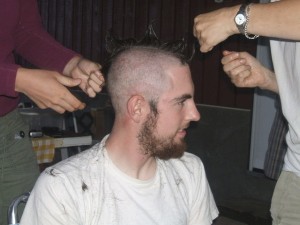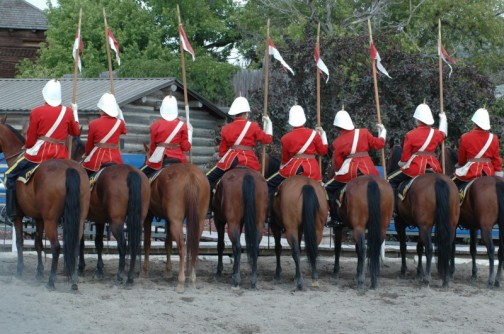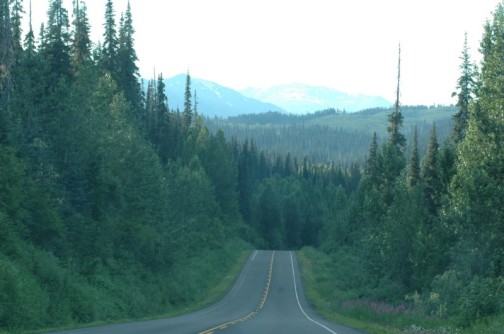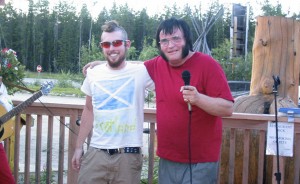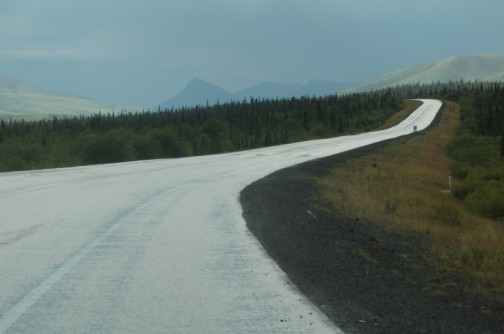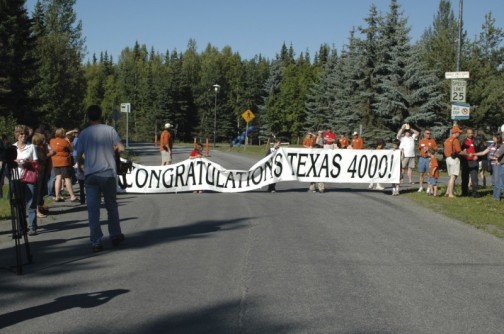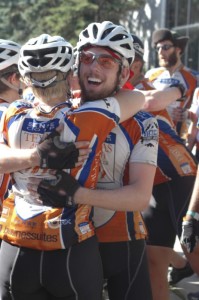“It’s the only sporting event in the world where it’s long enough, you probably need a haircut halfway through.”
–Sir Bradley Wiggins, Winner of The 2012 Tour de France.
The world’s most punishing sporting event lasts for three weeks and covers a bit over two thousand miles. That’s less than half as far as the world’s longest bicycle charity ride: 4,500 miles from Austin, Texas, to Anchorage, Alaska. Half the riders, the Sierra Team, cross into California and ride up the Pacific Coast. The other half heads north through Colorado, Wyoming, and Montana, thence into Canada. Back in 2007, my son was a member of the Rockies Team, and somewhere in the Yukon Territory he paused long enough to get a haircut. A very terrible Mohawk. It was at this point I decided I’d better jump in the car and drive up to see what the heck was going on with the clean-cut young college graduate who two months earlier had set out for the land of the midnight sun on a shiny new Trek road bike.
Unlike riders in the Tour de France, TK4 riders receive no compensation—other than a free road bike. In order to qualify, each must raise at least $4,000 in donations toward cancer research. There are no performance enhancing drugs involved, no comfort stations and only one support vehicle for the each team of 18 riders. Nighttimes, the crew either camps out or depends upon the kindness of strangers for lodging. Food? It varies. Often a church or civic benefactor will spring for a sit-down supper. More often, it’s oatmeal for breakfast, peanut butter or a hot dog for lunch. Toward the end of the ride, participants might find themselves competing with bears for roadside berries.
As I was saying, I was a bit concerned. Same with Alex’s mother, who had relocated to Washington, D.C., promising never to return to Salt Lake City until the bathroom remodel was finally finished. Earlier, I had ventured east to intercept the crew at Laramie, Wyoming. At that point, six of the male riders had grown beards and one was sporting a novelty haircut. All were smiling—at least for the group picture. No one had yet dropped out. I was impressed!
Weeks later, word from Alex that he had encountered a man in the Yukon claiming to be Elvis Presley. Concern turned to alarm. Had he warped into a parallel dimension? I decided I’d better drive up to Alaska and have a look-see. I’d never been to Alaska before, but then, how far could it be? I mean, Alaska is a state, right?
Across Montana I was driving through smoke, the result of numerous forest fires. Bright and early on the second day I arrived at the Canadian border, where I explained to the officer manning the checkpoint that I was driving north to Alaska to investigate an Elvis sighting, I was immediately ordered to park my car and step inside.
I’ve never held up well under interrogation, beginning in the second grade when my teacher’s purse went missing. Assuming that one of her pupils must have stolen it, she ordered each of us, one at a time, into the coat room. There she sat me down and demanded to know WHY I had taken her purse. Mine was the fourth of nine tearful confessions that day.
My first Canadian interrogator was a master of the craft. Unwavering eye contact as he evaluated my twitchy body language. A criminal background check was run, and to my surprise it turns out I’m not guilty of stealing Mrs. Faucet’s purse after all. I was handed back my passport and a slip of paper and told to report to a second officer. This one was quite beefy. I noticed he wore a bulletproof vest and carried a pistol on his hip. He took a long hard look at the piece of paper, then with a flourish ripped it in half.
“Welcome to Canada!” he said, and I was off.
Canada isn’t that much different from the United States. In Canadian English, the r’s and e’s are transposed and “color” is spelled “colour.” Whereas American signage features Spanish subtitles, in Canada the subtitles are in French. Distances are measured in kilometres, and instead of George Washington’s picture on a dollar, theirs features the queen of England and a loon. I couldn’t wait to change my dollars into “loonies,” and thus presently found myself waiting—and waiting—in a long line inside a Scotia Bank in Lethbridge. Only one listless teller was on duty, yet no one but me appeared to be put out by the sluggish service. Finally I gave up and marched next door to a Denny’s, where I waited for twenty minutes in vain for the hostess to appear. Tired of standing around, I decided to press on.
At Fort MacCleod I finally encountered a helpful native, who directed me to the nearest CBC bank. There I was greeted by an equally helpful teller, who showed me how to operate a Canadian ATM. Basically, what you do is insert your bank card, enter your PIN number and voila! Out comes a fistful of currency. She then offered to help me find my way back to my car; however, I assured her I am quite capable of managing by myself, thank you.
Once outside, I noticed a cloud of dust rising from behind the old log fort. A group of helmeted horsemen attired in red coats were conducting equestrian maneuvers. Above the fort flapped the Union Jack. All this was transpiring before an appreciative audience of Canadians, evidently content to live under the rule of the queen. And the loon.
Late afternoon found me at the entrance to Banff National Park, where vehicles were backed up at all four gates. I chose the shortest line, which turned out to be, inexplicably, the slowest. No cars were moving, but once again, no one was grumbling. A young woman dressed in a Day-Glo jump suit was flitting about, trying to get things moving, but no sooner had she gotten to the driver of the Corvette convertible in front of me than she stopped flitting and began flirting. I surmised the male driver of the Corvette must be a Canadian celebrity or some sort, because she asked him for his autograph. She handed him a piece of paper to sign; he dropped it. She picked it up, he signed it, handed it back. She dropped it!
At long last the line began to inch forward. At the ticket window, following a lengthy conversation with the ticket taker, the celebrity driver of the Corvette was handed a day pass. He dropped it.
It was Friday, the beginning of what I later would learn is a three-day holiday in Canada: Heritage Weekend. Come Heritage Weekend, each and every Canadian packs an ice chest, hitches up his boat to his camper—each and every Canadian does own a camper and a boat—and heads for Banff. Fifty miles or so past the park entrance the highway narrows to two lanes and that’s where the traffic began to slow. Then it ground to a halt. Over the next three hours I moved the distance of approximately one kilometre. How I wished I were on a bicycle, so I could forge ahead!
Unbelievably, there was no grumbling—except from me! Canadians are amazing. They stand for hours in an unmoving queue at the bank, wait for hours to be seated at a mediocre restaurant, don’t give a hoot when ushers hired to expedite traffic flow end up slowing it down. Come the weekend, they flee crowded Calgary in order to cool their heels and overheat their radiators in an epic traffic jam.
As the afternoon wore on, it occurred to me that I might very likely die of thirst or starve to death before I ever got through Banff. So I made a U-turn and headed back downhill toward Calgary. The line of backed-up campers and boats stretched for at least twenty miles. At Canmore I pulled into the drive-thru lane at the local Dairy Queen and ordered a Slushie. After a lengthy wait I finally arrived at the window, where I was handed a Blizzard.
“It’s the same price as a Slushie,” I was informed.
A few miles farther down the road I turned onto Route 22, and was happy to be headed north again, though disappointed I was no longer following in the tracks of the Texas 4000 Rockies team. Still, I was headed in the general direction of Alaska, and the traffic was relatively light. Eventually mine became the only car on the road, and I began to look for a place to spend the night. At a tiny town named Cremona, through a bug-bespattered windscreen, I spotted a motel, the Hawk’s Nest.
Attached to the motel was a bar, or perhaps it was someone’s basement rec room. In rural Canada, it’s hard to know whether you’re entering a commercial establishment or whether you’ve just blundered into someone’s house. It doesn’t help that the barmaid only glowers at you as you rummage through the refrigerator for a beer.
I was the only person who had come to Cremona to celebrate Heritage Weekend at the Hawk’s Nest. The manager was equally nonplussed when I returned shortly to ask if I could please have a light bulb.
A young Asian boy was summoned. I explained to him that in my haste to depart on my epic motor trip to Alaska, I had forgotten to pack any light bulbs. “There’s no light bulb in the lamp,” I said. “It has been snatched.”
“Smashed? Someone smashed the light bulb? Is there grass on the froor?”
“Maybe. I wouldn’t be surprised. Then again, it might just be mouldy shag carpeting, eh?” (Already I had begun to speak Canadian.)
I wasn’t asked to pay extra for the light bulb; however, I was assessed a five-dollar deposit on the room key. Bright and early the next morning I went looking for my five dollars, only to find the “office” was dark and the door locked. Presently I was hailed from the balcony of the Hawk’s Nest by a stark naked Asian man, and the exchange was hastily made.
I continued north on Rte. 22 to Highway 16, which took me west to Jasper National Park, where no cars were waiting in line at the entrance gate and where my day pass was still valid, barely. Compared to the previous day’s ride, it was lovely, with light traffic and mountain peaks not nearly as towering as those in Banff, but nonetheless impressive. Soon I was coasting down the western flank of the Canadian Rockies, into British Columbia—billed as “the most beautiful place on earth.”
It’s hard to argue with that. Compared to the parched plains, traffic jams and endless queues of Alberta, British Columbia is indeed a paradise. Evidently it rains there a lot, and as a result there is greenery every which way you look, and clear blue skies except when it’s raining, when everything turns somber and gray. On such a gray day a town like Prince George can seem awfully dreary, and you have to wonder what the suicide rate is among the citizens who dwell there and have no place to socialize other than ill-lighted, wood-paneled restaurants and bars resembling basement recreation rooms. And what is the mortality rate among short-order cooks? Every restaurant in town had a “Help Wanted” sign in the window, and the dishes I was served seemed to cry out “No Experience Necessary.”
I pulled out of Prince George in a dark mood, which gradually brightened as the cloud cover lifted and the sun broke through. For two months I had been following the progress of the Rockies Team, via the T4K website and from outer space via Google Earth. And now here I was at ground level, cruising along pavement they had peddled, blowing through towns and past campgrounds where they had stopped for the night: Vanderhoof, Burns Lake, Smithers, Kitwanga—where it seemed prudent to top off the fuel tank, since gas stations were becoming fewer and farther between.
At Kitwanga, the Rockies Team had turned north toward the Yukon Territory on Rte. 37, also known as the Stewart-Cassiar Highway. Alas, I didn’t have a road map, nor was I able to buy one at the filling station, so I couldn’t be sure exactly how far it was going to be to the next village. However, I remembered the team had stayed at a place called Dease Lake, and so I entered that name as my next destination on my Garmin GPS Street Pilot and proceeded north. No sooner had I put the car into gear than my onboard computer, like Stanley Kubrick’s Hal 5000, turned mutinous.
“Recalculating,” said Ms. Garmin. “Turn right, then turn left, proceed five hundred feet.”
I did as I was told, only to find myself right back at Kitwanda Junction. Again I set out on Rte. 37, heading north.
“Recalculating,” said Ms. Garmin, somewhat testily this time. “Turn right, turn left, proceed five hundred feet, turn left.”
This time I did as I was told. “Continue,” said Ms. Garmin, “297 miles.”
What? Ms. Garmin was ordering me to retreat, all the way back to Smithers. Was it a glitch in the software or did Ms. Garmin know something about Rte. 37 that I didn’t? What about all the mud I’d seen on all those vehicles at the filling station? Was the road even paved? If not, what chance did I have in a Volkswagen Golf with only four inches of ground clearance? And why was there no road sign giving the mileage to Dease Lake? Only road sign I had seen was made of cardboard. The road was “open” it read, but I had the feeling that could change at any moment.
Turns out Rte. 37 is one stretch of pavement I won’t soon forget. It’s beautiful, but it also goes on and on forever. Now and again a bear will cross the road, or a moose. If you should encounter another vehicle, which is seldom, it will either be a monstrous motor home juggernaut piloted by a retired couple, or else a pickup truck with a wickiup camper in the bed and a canoe duct taped to the roof, driven by a bearded gent who looks a lot like Red Green. Bicyclists? You’d have to be crazy!
In August in northern British Columbia, night doesn’t actually fall, but eventually I got sleepy and elected to partially stretch out inside the boot of the Golf rather than pitch my tent amid the mosquitoes and bears. It wasn’t great, but in the morning I awoke refreshed—as only a Scotsman who has cheated the innkeeper can feel refreshed. I continued on, and on, and on some more, eventually arriving at Meziadin Junction. It was from here that Alex and two of his buddies had set out to break a one-day distance record by peddling over two hundred miles in a single day. When I first read of this, in teammate Chris McCraw’s journal, I assumed my son had volunteered for the ride because he is exceptionally bold. I later learned almost everyone on the team would have gladly volunteered, but it didn’t seem right to abandon the slowest rider, Katie, to the mercy of the bears. By forging ahead, Alex, Chris, and Shawn would buy themselves three blessed days away from the plodding crowd! And, hopefully, get a break from the monotony of pancakes for breakfast, peanut butter and stale bread for lunch, rice and beans for supper.
Unfortunately, the trio had been slowed by a stretch of highway construction. Due to liability concerns, they’d been forced to traverse a gravelly stretch in the pilot car—much to their dismay.
“We had one guy through here who absolutely refused to get in the truck,” said the flagman. “He was determined to ride his bicycle every inch of the way.”
As he and I awaited the arrival of the pilot truck, the flagman told me he was a native of Iskut. He wore a woolen shirt, down-filled vest, insulated jeans, boots and hat. I was wearing sandals, shorts, and a tee shirt.
“Damn, it’s cold this morning,” he muttered.
Last thing I expected to encounter on my trip to Alaska is an Eskimo complaining of the cold in the middle of the summer.
Eventually I arrived at Dease Lake, where I enjoyed a plate of eggs and sausage at Mama Z’s. Leafing through the guest register I spotted familiar names. Claire, Usman, Natalie… The cashier said she remembered them. The trail was warm!
Route 37 eventually terminates at the Alcan Highway, where I sprang for an expensive night at Nugget City after hearing from the proprietor that some previous guests, having learned of their noble mission, had picked up a Rockies team restaurant tab in excess of four hundred dollars. So how could I complain about paying $150 for a wee cabin? I later learned from Alex that the tab had been closer to two hundred—but that included a free concert on the deck featuring none other than Elvis Presley!
I awoke depressed, as only a Scotsman who has just blown $150 on a room for the night can be depressed. It didn’t help my mood that it was raining, and dark. Knowing that my son and his friends had peddled through many such storms and had passed many a night in muddy campgrounds with no shelter but porous pup tents, didn’t cheer me.
The Yukon Territory numbers only about thirty thousand human inhabitants, half of whom reside in Whitehorse. I remembered the Rockies Team had spent a full day of R&R there, and I decided to walk around a bit as well. I visited a superstore, a Canadian version of WalMart, and marveled at the wide selection of exotic foods. I discovered that in Canada, Canadian bacon is known simply as “bacon.”
In the lower forty-eight, the T4K team was often treated and feted by various churches; however, in the Far North churches had become a rarity. As a result, the Rockies riders were becoming dirtier and hungrier by the day. Things only got wilder after they reunited with the Sierra Team. Evidently the Sierra Team had been eating much better, and were aghast to learn their counterparts had been surviving on a meager diet of rice and beans and peanut butter. Things became quite heated when the Sierra Team refused to share, and a shouting match resulted. Only after a member of the Sierra Team was invited to participate in the savage Rockies “haka” ceremony did tempers begin to cool. Still, there remained philosophical differences. For example, the Sierra Team was headed by a former submariner named Jordan, who insisted on military discipline and pre-dawn launches. He liked to ride hard and fast. By contrast the Rockies Team leader, Daniel, was much more laid-back. Although recognized at the team’s strongest rider, Daniel was disinclined to show off and was happy to delegate authority—or forget about authority altogether. Often the team wouldn’t get underway until noon, and why should they? In the Far North in the summertime there’s plenty of daylight, so what’s the point in getting an early start?
By the time I finally caught up with them, the compact peloton that had rolled out of Austin two months earlier had become a ragged line of widely-spaced riders stretching for miles. Some rode solo, others in pairs. Each time I spied a burnt orange jersey I slowed for a closer look, but it was hard to tell which rider was my son, since the bikes are more or less identical and the riders had all become equally soiled and shabby. But wait! There he is! My son, Grizzly Adams!
Alex was riding alongside the magnificently hirsute Eric Marlowe, and I treated the pair to a lunch of hamburgers and fries at The Blue Whale in Glen Ellen. We were in Alaska now, and from my perspective as a motorist, the long ride was already over. I told Alex I would wait for him farther up the road, and away I went to Palmer, where I booked a comfortable room for two nights. Outside, lightning flashed and thunder rattled the windows. Now and again an ambulance or patrol car would rush past, siren screaming. It was hard to sleep, knowing that the intrepid bicyclists were somewhere out there in the darkness. Indeed, down the home stretch the hardships and drama only intensified. The unflappable Michael Glass, who had earlier survived a poisonous spider bite, was rear-ended by an SUV. The impact shattered his rear wheel and sent him sailing. Regaining his feet and doffing his cracked helmet, he addressed the two occupants of the car, who sat staring ahead, half-paralyzed from shock.
“So…where are you folks from?”
Descending a steep grade, Usman Cheema took a hard spill and was rushed to the nearest hospital. In spite of a bruised liver, he soon rejoined his friends and somehow remounted his bike.
Lastly, some guy attempted to abduct Allyson! At the time she was riding solo; he was parked beside the road, the hood of his car up, his license plate obscured by a rag. When Allyson stopped to offer help, he pulled out a screw driver and attempted to drag her into the shrubbery. However, Allyson, aka “Tank Girl” wasn’t about to go quietly. Presently Daniel appeared and managed to flag down a motorist, who had a cell phone. Result: The would-be abductor, a registered sex offender, is now behind bars.
On the final day, at a place called Mirror Lake, the bikers were greeted by a delegation comprising University of Texas alumni and a small band of proud, albeit anxious parents. Vast quantities of Blue Bell ice cream, soda pop, cookies, barbecued beef and Subway sandwiches were consumed. The weather couldn’t have been nicer, and even the mosquitoes stayed away.
Aches and pains and bruises notwithstanding, there was joy in the air, and it could very well have ended then and there, except that an even larger crowd of Texas Exes and an even bigger feast was awaiting just a few miles farther up the road in Anchorage.
Not before nor since have I ever seen a happier group of young people. Or, as Nelson so elegantly phrased it, as he tucked into a steaming hot bowl of black bear chili, “I’m so relieved that I’m the one eating the bear, and not the other way around.”
